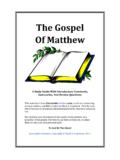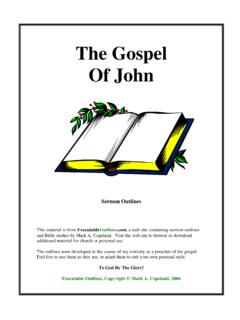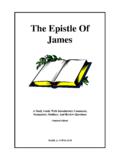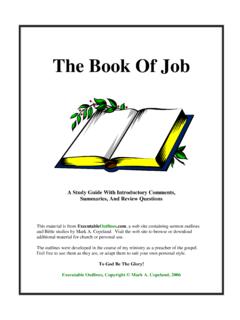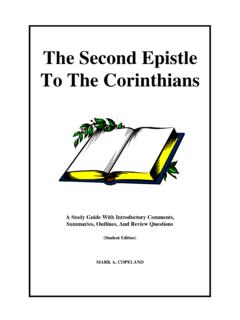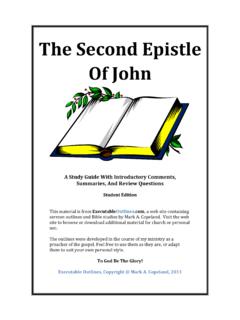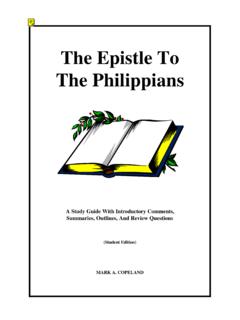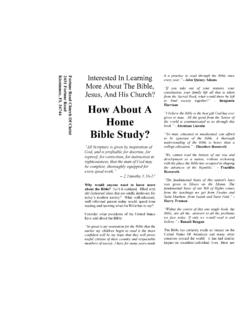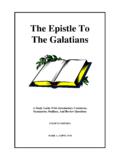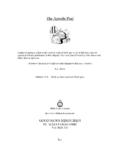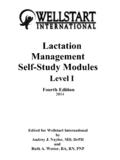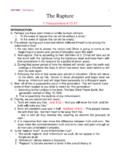Transcription of The First Epistle To Timothy - Executable Outlines
1 The First EpistleTo TimothyA Study Guide With Introductory Comments,Summaries, Outlines , And Review QuestionsMARK A. COPELANDThe First Epistle To TimothyTable Of ContentsIntroduction3 Chapter One7 Chapter Two11 Chapter Three14 Chapter Four17 Chapter Five20 Chapter Six24 This study guide was developed in preparation for teaching adult Bible objectives for each section are usually things I plan to emphasize during have found that summarizing and outlining helps me to better understand the Wordof God. It is a practice I highly recommend to generally delete the answers to the review questions before printing the materialand giving it to the students. But that you might know what answers were intendedby the questions, I have included them in these material is from , a web site containing sermon outlinesand Bible studies by Mark A. Copeland. Visit the web site to browse or downloadadditional material for church or personal Outlines were developed in the course of my ministry as a preacher of the free to use them as they are, or adapt them to suit your own personal style.
2 ToGod be the glory! Executable Outlines , Copyright Mark A. Copeland, A. CopelandThe First Epistle To Timothy 2 The First Epistle To TimothyIntroductionAUTHORThe apostle Paul, as stated in the salutation (1:1). The internal evidence certainly supports Paul as theauthor, especially references to his earlier life (1:13), and the close relationship between the author andTimothy (1:2; cf. Ph 2:22). Early sources in church history that attribute this letter to Paul include: Eusebius (300 ), Origen (250 ), Clement of Alexandria (200 ), Tertullian (200 ),Irenaeus (200 ), the Muratorian Fragment (180 ). References to the Epistle are also found inthe writings of Theophilus of Antioch (180 ), Justin Martyr (160 ), Polycarp (135 ), andClement of Rome (90 ).RECIPIENTT imothy, Paul s true son in the faith (1:2,18). We are First introduced to Timothy in Ac 16:1-3,where we learn that his mother was Jewish (cf. also 2 Ti 1:5; 3:14-15) and his father Greek. Wellspoken of by the brethren at Lystra and Iconium, Paul desired that the young disciple travel with himand therefore had him circumcised to accommodate Jews they would seek to evangelize.
3 This began along relationship of service together in the work of the Lord, in which Timothy served Paul as a sonwould his father (Ph 2:19-24). Such service included not only traveling with Paul, but remaining withnew congregations when Paul had to leave suddenly (Ac 17:13-14), going back to encourage suchcongregations (1 Th 3:1-3), and serving as Paul s personal emissary (1 Co 16:10-11; Ph 2:19-24).He had the honor of joining Paul in the salutation of several epistles written by Paul (2 Co 1:1; Ph 1:1;Co 1:1; 1 Th 1:1; 2 Th 1:1), and from such epistles we learn that Timothy had been with Paul duringhis imprisonment at Rome. Such faithful service helps us to appreciate why Paul would leave him inEphesus (1:3)TIME AND PLACE OF WRITINGSome commentators (such as Barnes) believe that Paul may have penned 1st Timothy after his extendedstay at Ephesus and departure to Macedonia on his third missionary journey (cf. Ac 19:1-41; 20:1-3).This would place its composition around 58-59 general consensus, though, is that Paul wrote this Epistle from Macedonia, following his firstimprisonment in Rome (cf.)
4 Ac 28:16,30-31). Paul was released and allowed to travel for several yearsbefore being arrested again and finally put to death by Nero. It is possible to conjecture from severalreferences in his epistles that he went to places like Philippi (Ph 1:26; 2:24), Colosse (Phile 22), andeven Spain (Ro 15:24,28). With more certainty his destinations included Ephesus (where he leftTimothy, 1 Ti 1:3), Macedonia (where he wrote 1st Timothy , 1 Ti 1:3), Crete (where he left Titus, Ti1:5), Miletus (2 Ti 4:20), Corinth (2 Ti 4:20), and a winter at Nicopolis (2 Ti 4:20). Any attempt todetermine the exact order of these visits is pure speculation, however. If 1st Timothy was indeedwritten during this period, the date would be around 63-64 A. CopelandThe First Epistle To Timothy 3 PURPOSE OF THE EPISTLEPaul had left Timothy behind at Ephesus with an awesome responsibility: to charge some not to teachanything contrary to the sound doctrine which was according to the glorious gospel of the blessedGod (1:3-11).
5 Fulfilling this charge was made difficult by Timothy s youth and natural timidity(4:11-12; cf. 2 Ti 1:7-8). While Paul hoped to come himself, he writes Timothy to guide him in themeantime (1 Ti 3:14-15). Therefore, Paul writes: To instruct Timothy on how to conduct himself while administering the affairs of the church(3:14-15) To encourage Timothy by providing counsel concerning his own spiritual progress (4:12-16)THEME OF THE EPISTLEThis letter is addressed to a young evangelist charged with the responsibility of working with acongregation and guiding them in the right way. Everything that is written is designed to aid both himand the congregation in doctrine and conduct. An appropriate theme for this Epistle might therefore be: SOUND DOCTRINE FOR A CONGREGATION AND ITS PREACHER KEY VERSES: 1 Timothy 3:14-15 These things I write to you, though I hope to come to you shortly; but if I amdelayed, I write so that you may know how you ought to conduct yourself in thehouse of God, which is the church of the living God, the pillar and ground ofthe truth.
6 OUTLINEINTRODUCTION (1:1-2) CONCERNING SOUND DOCTRINE (1:3-20) SOUND DOCTRINE (1:3-11) FOR THE LORD S GRACE AND MERCY (1:12-17) S RESPONSIBILITY (1:18-20) INSTRUCTIONS CONCERNING THE CHURCH (2:1-3:13) PRACTICE OF PRAYER (2:1-8)Mark A. CopelandThe First Epistle To Timothy FOR WOMEN (2:9-15) FOR CHURCH OFFICERS (3:1-13) bishops (3:1-7) deacons (3:8-13) TO Timothy (3:14-6:19) S PURPOSE IN WRITING (3:14-16) THE SPIRIT S WARNING OF APOSTASY (4:1-6) YOURSELF UNTO GODLINESS (4:7-16) CONCERNING MEMBERS OF THE CHURCH (5:1-6:19) PROPER RELATIONSHIPS (5:1-2) WIDOWS (5:3-16) ELDERS (5:17-25) SERVANTS (6:1-2) TEACHERS MOTIVATED BY GREED (6:3-10) THE MAN OF GOD HIMSELF (6:11-16) THE RICH (6:17-19)CONCLUDING CHARGE TO Timothy (6:20-21)REVIEW QUESTIONS FOR THE INTRODUCTION1)Where do we First read about Timothy ?- Acts 16:1-32)What was the name of his grandmother and mother? (2 Ti 1:5)- Lois (grandmother)- Eunice (mother)3)How did Paul affectionately regard Timothy ?
7 (1:2)- As his true son in the faith4)Where was Timothy when Paul wrote this Epistle ? (1:3)Mark A. CopelandThe First Epistle To Timothy 5- Ephesus5)What is the general consensus for the time and place that Paul wrote this letter?- After his First Roman imprisonment, sometime around 63-64 While in Macedonia, shortly after leaving Ephesus6)What twofold purpose does Paul have in writing this Epistle ?- To instruct Timothy on how to conduct himself while administering the affairs of the church- To encourage Timothy by providing counsel concerning his own spiritual progress7)What is the theme of this Epistle , as suggested in the introductory material?- Sound doctrine for a congregation and its preacher8)What are the key verses?- 1 Ti 3:14-159)According to the outline proposed above, what are the main points of this Epistle ?- Charge concerning sound doctrine- General instructions concerning the church- Advice to Timothy - Instructions concerning members of the churchMark A.
8 CopelandThe First Epistle To Timothy 6 The First Epistle To TimothyChapter OneOBJECTIVES IN STUDYING THIS CHAPTER1)To notice two different kinds of teaching: one that gives rise to disputes, and the other whichproduces godly edification in faith2)To consider what ought to be the goal of all teaching: love from a pure heart, a good conscience,and sincere faith3)To appreciate the example of Paul s conversion in how longsuffering Christ is to those who believeon HimSUMMARYPaul begins this Epistle by urging his true son in the faith to remain in Ephesus and charge some not toteach other doctrines, nor give heed to fables and genealogies that cause disputes rather than godlyedification in faith. The goal of this commandment is love from a pure heart, a good conscience, andsincere faith, from which some have strayed and turned to idle talk in their desire to be teachers of thelaw. While the law is good when used properly, it is not designed for the righteous person, but for thosewhose conduct is contrary to sound doctrine which is according to the gospel of God committed toPaul s trust (1-11).
9 Speaking of what was committed to Paul s trust sparks an expression of thanksgiving and praise toChrist for counting him faithful and enabling him to be of service. His gratitude is heightened byremembering what he had been prior to receiving the grace and mercy of the Lord. But Jesus came intothe world to save sinners, of whom Paul was chief, and in him Christ shows an example of Hislongsuffering to those who believe on Him for everlasting life (12-17).Paul then charges Timothy to carry out his responsibility in keeping with prophecies made concerninghim. The charge is to wage the good warfare, having faith and a good conscience . He is reminded oftwo men, Hymenaeus and Alexander, who have rejected such things. As a result they had sufferedshipwreck concerning the faith and had been turned over to Satan by Paul that they might learn not toblaspheme (18-20). (1-2) AUTHOR (1) , an apostle of Jesus Christ (1a) the commandment of God our Savior and Jesus Christ our hope (1b)Mark A.
10 CopelandThe First Epistle To Timothy RECIPIENT (2) (2a) s true son in the faith (2b) (2c) , mercy, and God our Father and Jesus Christ our SOUND DOCTRINE (3-11) S CHARGE TO Timothy (3-7) in Ephesus and charge (3a) teach no other doctrine (3b) give heed to fables and endless genealogies (4a)1)Which cause disputes (4b)2)Rather than godly edification which is in faith (4c) purpose of the commandment (5a) from a pure heart (5b) good conscience (5c) faith (5d) some have (6a) turned aside to idle talk (6b) to be teachers of the law (7a)1)Not understanding what they say (7b)2)Nor the things they affirm (7c) PROPER USE OF THE LAW (8-11) is good if one uses it lawfully (8) law is not made for the righteous (9a) for all sorts of sinners (9b-10a) anything else that is contrary to sound doctrine (10b)1)According to the glorious gospel of the blessed God (11a)2)Which was committed to Paul s trust (11b) FOR THE LORD S GRACE AND MERCY (12-17) TO CHRIST JESUS (12-14) enabling him (12a) He counted him faithful (12b) him into the ministry (12c) he had formerly (13a) blasphemer (13b) persecutor (13c) insolent man (13d).
